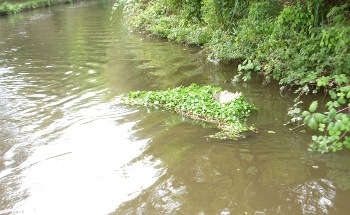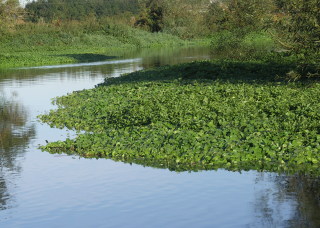THE invasive quick growing weed, Floating Pennywort, firmly established in the canals and rivers of the South and Midlands, is now spreading North.
 Two years ago it was rampant on the Soar, but an all-out attempt by volunteers last year managed to clear the worst of it, but now it has spread to the northern waterways. The picture shows British Waterways staff attempting to get a boat through the weed clogged North Lock in Leicester.
Two years ago it was rampant on the Soar, but an all-out attempt by volunteers last year managed to clear the worst of it, but now it has spread to the northern waterways. The picture shows British Waterways staff attempting to get a boat through the weed clogged North Lock in Leicester.
Both British Waterways and the Environment Agency are making a combined effort to clear the weed this week on the northern waterways, before it gets too well established during the summer months, for it can regenerate from the smallest fragment.
 During our cruise last year we noticed that there were small clumps of Floating Pennywort both on the Rochdale and Ashton canals, but these can grow alarmingly, and soon clog up the waterways, growing at up to 1 inch a day. The picture shows a small clump on the Ashton.
During our cruise last year we noticed that there were small clumps of Floating Pennywort both on the Rochdale and Ashton canals, but these can grow alarmingly, and soon clog up the waterways, growing at up to 1 inch a day. The picture shows a small clump on the Ashton.
It is now established on both the Calder & Hebble and Aire & Calder navigations, with a particularly thick spread at the Figure of Three Locks at Horbury on the Calder & Hebble.
Campaign
Defra has announced its Be Plant Wise campaign, which aims to raise awareness among gardeners, pond owners and retailers of the damage caused by invasive aquatic plants. We are told that British Waterways spend over £350,000 in aquatic plant removal annually.
 Floating Pennywort, a native species of North America, was brought to Britain in the 1980s as a plant for tropical aquaria and garden ponds. By 1991 it had become present in the wild and has since found its way onto parts of the inland waterways network from people releasing them from their ponds and aquariums. If left unchecked it can form thick mats, starving waterways of sunlight and oxygen and interfering with boating, angling and wildlife.
Floating Pennywort, a native species of North America, was brought to Britain in the 1980s as a plant for tropical aquaria and garden ponds. By 1991 it had become present in the wild and has since found its way onto parts of the inland waterways network from people releasing them from their ponds and aquariums. If left unchecked it can form thick mats, starving waterways of sunlight and oxygen and interfering with boating, angling and wildlife.
Drowned
A cow was actually drowned in the Soar believing the thick carpet of weed was firm ground.
Jonathan Hart-Woods, Environment Manager for British Waterways explains about the weed:
"Floating Pennywort demands ongoing monitoring and intensive action to control it as it can spread at such an alarming rate. To be effective we need to mechanically dig out the weed, as well as using a licenced herbicide to kill the weed to try and prevent the spread as much as possible. However, this is not easily achievable due to its ability to grow from fragments as small as 10mm in length."
Other invasive plants putting a strain on the waterway system are Japanese Knotweed, Himalayan Balsam and Giant Hogweed. The government has advised gardeners to be aware of what they are growing in their ponds and dispose of plants carefully, and not in canals or rivers.
